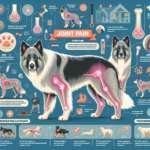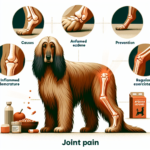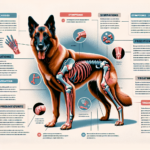Pyrenean Shepherd Joint Pain: Causes, Symptoms, Prevention, and Treatment

Introduction
The Pyrenean Shepherd, also known as the Berger des Pyrénées, is a small to medium-sized herding dog originating from the Pyrenees Mountains in France. Known for their agility, intelligence, and boundless energy, these dogs have been invaluable to shepherds for centuries. They come in two coat varieties: the rough-faced and the smooth-faced, each with its unique charm. Despite their robust nature, Pyrenean Shepherds are not immune to health issues, with joint pain being a significant concern.
Joint health is crucial for Pyrenean Shepherds due to their active lifestyle and herding background. Joint pain can severely impact their quality of life, making it essential for owners to understand the causes, symptoms, prevention, and treatment options available.
Breed-Specific Joint Pain Risks
Genetic Predisposition
Pyrenean Shepherds, like many other breeds, are genetically predisposed to certain joint-related issues. Hip dysplasia, a condition where the hip joint doesn’t fit into the hip socket properly, is relatively common. This misalignment can lead to arthritis and chronic pain. Elbow dysplasia, another genetic condition, affects the elbow joint and can cause similar issues. Arthritis, a degenerative joint disease, is also prevalent in this breed, often exacerbated by their high activity levels.
Age-Related Risks
As Pyrenean Shepherds age, the risk of joint pain increases. While they are generally healthy dogs, the wear and tear on their joints from years of activity can lead to conditions like osteoarthritis. Owners should be particularly vigilant as their dogs approach middle age, around 6-8 years, as this is when joint issues often start to manifest.
Activity Level and Joint Stress
Pyrenean Shepherds are known for their high energy levels and need for regular, vigorous exercise. While this is excellent for their overall health, it can also put significant stress on their joints. Activities like herding, agility training, and long runs can exacerbate existing joint issues or contribute to the development of new ones. It’s crucial to balance their need for exercise with joint health considerations.
Common Symptoms of Joint Pain in Pyrenean Shepherds
General Symptoms
- Limping: One of the most noticeable signs of joint pain is limping or favoring one leg over another.
- Stiffness: Dogs may show stiffness, especially after resting or sleeping.
- Reluctance to Move: A dog in pain may be hesitant to jump, run, or even walk.
- Swelling: Joints may appear swollen or feel warm to the touch.
- Behavioral Changes: Irritability or changes in behavior can also indicate discomfort.
Breed-Specific Symptoms
In Pyrenean Shepherds, joint pain may manifest as a reluctance to perform tasks they once enjoyed, such as herding or agility exercises. They may also show a decrease in their typically high energy levels and enthusiasm for play.
When to Consult a Vet
If you notice any of the above symptoms, it’s essential to consult a veterinarian promptly. Early diagnosis and treatment can significantly improve your dog’s quality of life and prevent further joint damage.
Preventive Measures for Joint Health
Exercise Recommendations
While exercise is crucial for Pyrenean Shepherds, it’s essential to choose activities that are gentle on their joints. Swimming is an excellent low-impact exercise that can help maintain muscle mass without stressing the joints. Regular, moderate walks and controlled play sessions are also beneficial. Avoid high-impact activities like jumping or running on hard surfaces.
Dietary Suggestions
A balanced diet rich in essential nutrients can support joint health. Foods high in omega-3 fatty acids, such as fish oil, can reduce inflammation. Glucosamine and chondroitin supplements are also beneficial for maintaining joint cartilage. Always consult your vet before adding supplements to your dog’s diet.
Weight Management
Maintaining a healthy weight is crucial for reducing joint stress. Overweight dogs are more prone to joint issues, so it’s essential to monitor your Pyrenean Shepherd’s weight and adjust their diet and exercise routine accordingly. Regular vet check-ups can help ensure your dog stays within a healthy weight range.
Early Screening and Monitoring
Regular veterinary check-ups are essential for early detection of joint issues. Screening tests like X-rays can help identify problems before they become severe. Monitoring your dog’s behavior and physical condition can also provide early warning signs of joint pain.
Treatment Options for Joint Pain
Non-Surgical Treatments
Non-surgical treatments are often the first line of defense against joint pain. These can include:
- Medications: Anti-inflammatory drugs and pain relievers can help manage symptoms.
- Physical Therapy: Exercises designed to strengthen muscles and improve joint function.
- Lifestyle Adjustments: Modifying exercise routines and providing a comfortable living environment.
Surgical Options
If non-surgical treatments are ineffective, surgical options may be considered. These can include:
- Joint Replacement: Replacing the affected joint with an artificial one.
- Arthroscopy: A minimally invasive procedure to clean out the joint.
- Osteotomy: Cutting and realigning bones to improve joint function.
Alternative Therapies
Alternative therapies can also provide relief for joint pain. These include:
- Acupuncture: Using needles to stimulate specific points on the body.
- Hydrotherapy: Water-based exercises to reduce joint stress.
- Massage: Gentle massage to improve circulation and reduce pain.
Lifestyle and Management Tips
Daily Care Routine
A consistent daily care routine can help manage joint pain. This can include:
- Regular Exercise: Gentle, consistent exercise to maintain muscle mass.
- Balanced Diet: A diet rich in essential nutrients and supplements.
- Medication: Administering prescribed medications as directed by your vet.
Modifying the Home Environment
Making your home more comfortable for a dog with joint pain can significantly improve their quality of life. Consider the following modifications:
- Ramps: Install ramps to help your dog navigate stairs or get onto furniture.
- Orthopedic Beds: Provide a supportive bed to reduce pressure on joints.
- Non-Slip Flooring: Ensure floors are non-slip to prevent falls and injuries.
Long-Term Management
Long-term management strategies are essential for keeping your Pyrenean Shepherd active and happy despite joint pain. These can include:
- Regular Vet Check-Ups: Frequent visits to the vet for monitoring and adjustments to treatment plans.
- Consistent Routine: Maintaining a consistent exercise and medication routine.
- Monitoring Weight: Regularly checking your dog’s weight and adjusting their diet as needed.
FAQs About Pyrenean Shepherds and Joint Pain
What are the early signs of joint pain in Pyrenean Shepherds?
Early signs include limping, stiffness, reluctance to move, and behavioral changes such as irritability or decreased enthusiasm for play.
Can joint pain in Pyrenean Shepherds be prevented?
While genetic predispositions can’t be entirely prevented, maintaining a healthy weight, providing a balanced diet, and ensuring regular, low-impact exercise can significantly reduce the risk of joint pain.
Are there specific foods that can help with joint health?
Yes, foods rich in omega-3 fatty acids, glucosamine, and chondroitin can support joint health. Always consult your vet before making dietary changes.
When should I consult a vet about my dog’s joint pain?
If you notice any signs of joint pain, such as limping, stiffness, or reluctance to move, it’s essential to consult a vet promptly for early diagnosis and treatment.
Conclusion
Joint pain is a significant concern for Pyrenean Shepherds, given their active lifestyle and genetic predispositions. Understanding the causes, symptoms, prevention, and treatment options is crucial for maintaining their quality of life. By taking preventive measures, providing appropriate care, and consulting with a veterinarian regularly, you can help ensure your Pyrenean Shepherd remains healthy and active for years to come.




